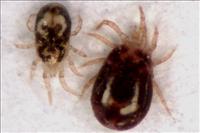
Caption:
Photo by: Michael R. Bush
|
|
Bird mites
(revision date: 7/14/2015)
Use Integrated Pest Management (IPM) for successful pest management.
Biology
Northern fowl mites and chicken mites are blood-sucking parasites of domestic poultry and wild birds throughout much of the United States. Both species can become a pest in the home when starlings, pigeons, sparrows, or other wild birds nest in the eaves, attic, chimney, etc. The mites typically feed only on birds, but when disturbed or when their bird hosts die or vacate a structure, the mites will migrate to any available food source, including humans. Bites usually occur at night and result in small, irritating, itchy or painful pimple-like bumps. Adult mites are around 1 mm long (1/25th of an inch). Color varies from translucent whitish to red (recently fed) to grayish-brown (blood meal is partially digested). Adult mites have 8 legs, two body parts (tiny head and larger body), and are roughly oval in shape with a rounded rear end. Northern fowl mites typically spend most of their life on the host bird, only leaving when the host dies or when populations become so high they must find another host. They may also be found in nests or on eggs. This species tends to be more active in cooler temperatures, around 65-68 degrees F. Unlike Northern fowl mites, chicken mites feed on their hosts mainly at night, then leave the host to spend the rest of their time in sheltered areas such as nests or cracks and crevices near roosting sites. Chicken mites, also known as red mites, prefer warmer temperatures than Northern fowl mites and tend to be more numerous in warmer weather. Under good conditions, both species mature from egg to reproductive adult in as little as 7 days, allowing populations to build very quickly. Northern fowl mite adults may survive up to 3 weeks off their host birds, but chicken mites may survive up to 8 months without a host. Poultry and their housing, roosts, and bedding materials are often infested. On chickens, mites tend to congregate on feathers near the vent and on the back. High numbers of mites on poultry can cause a reduction in egg production, anemia due to blood loss, and even death, particularly of young chicks. Bird mites are not known to transmit disease to humans, but may transmit diseases between birds.
|
|
Management Options
Non-Chemical Management
- Bird-proof the home by closing off access points. Caulk small openings and use wire mesh to screen vents and larger openings. Chimneys should have a cap with a mesh screen small enough to exclude birds.
- Birds can be discouraged from roosting by covering their favorite spots with wire screen or netting, or by attaching bird-repellent needle strips to ledges and windowsills.
- Remove abandoned nests quickly, before mites have the opportunity to enter buildings. Wear gloves when removing nests. Pigeon, house sparrow, and starling nests may be removed at any time, even if birds or eggs are present. Songbirds, however, are protected by federal law and the eggs and young may not be disturbed. Songbird nests can only be removed after the young have left the nest.
- Trim tree branches and shrubs away from the house, especially along the roof.
- Inside the home, vacuum regularly to collect any wandering, hungry mites. Seal and dispose of the vacuum bag to prevent escape of any mites that survive the vacuuming process. Freezing the sealed bag will also kill the mites.
- Wipe up mites from inside surfaces with a soapy sponge or a cloth dampened with rubbing alcohol.
- Bird mites do not survive and reproduce on human blood, so will eventually disperse or die if they do not have suitable hosts. They can survive without an avian (bird) host for 2-4 weeks.
- For backyard poultry, a 2-week quarantine period is recommended for new birds before adding them to an existing flock. Carefully inspect new birds for mites and other parasites. Northern fowl mites will be on the host birds day or night, while the nocturnal chicken mites are usually only found at night.
- Clean and inspect poultry housing regularly. Chicken mites live in cracks and crevices, not on the birds. Easy-to-clean roosts and nests with few hiding places for mites should be used. For more information on management of mites on poultry or in poultry houses, contact your local Extension office.
Select non-chemical management options as your first choice!
Chemical Management
Use non-chemical control methods first. Exclusion/removal of birds and nests and regular vacuuming may control small infestations without the need to resort to chemical control measures. If chemical treatments in an attic or crawlspace are necessary contact a licensed pest management professional.
|
